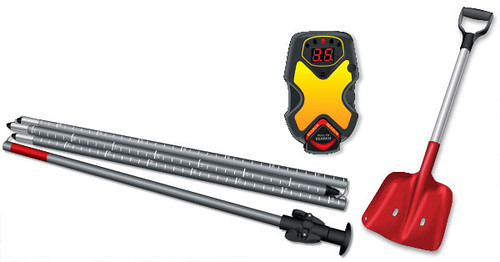
Every snowmobile rider in avalanche country needs to carry rescue gear on their back, not on the machine. They should also know how to use the gear. (U.S. Forest Service National Avalanche Center)
It’s early into the winter sports season and already there are stories of avalanche victims on the nation’s slopes.
But there are some steps you can take to keep your name and those of your companions out of the statistics record.
The U.S. Forest Service is a partner in the Learn to Ski and Snowboard Month, an effort to encourage children and adults to take lessons to improve their skills. Knowing about avalanches is vital to your safety.
The first step is to know before you go. If you’re venturing onto the backcountry trails on U.S. Forest Service lands, check with the local Forest Service office to learn about the conditions in the area you’re going to visit. Many national forests have their own avalanche information centers.
Secondly is to be prepared. Everyone in your party must have and know how to use a shovel, a probe and an avalanche beacon. Be sure that all members can perform a fast and effective rescue by practicing BEFORE you go out.

In mountainous areas where avalanches may be a problem, be sure to carry these items - Transceiver (beeper): A transceiver lets rescuers locate you if you’re trapped in an avalanche. Riders set their transceivers to “transmit” normally. After an avalanche, rescuers switch theirs to “receive.” Avalanche probes: Similar to lightweight tent poles, these probes let you search for persons or objects hidden under the snow. You also can use them to check the depth or firmness of the snow. Shovel: You can dig out an avalanche victim. You also may need to dig out your own sled if it gets stuck in snow. Photo courtesy Indiana Department of Natural Resources.
And thirdly, travel wisely. Practice low-risk travel on the snow by staying on low-angle terrain. That means eliminating and/or minimizing your exposure to avalanche terrain and never exposing more than one person at a time to potential avalanche danger.
For further protection, Forest Service winter sports specialist Dennis Hogan strongly suggests that you and your partners get training and take an avalanche class before you head out. This will help you better understand avalanche red flags.
“That means watching for changing conditions whenever the weather, snowpack or terrain changes,” Hogan said. “It also means being flexible and ready to change your plans if you run into any of the red flags.”
“The importance of knowing when to turn back and try again later when conditions are unstable is a critical part of safe backcountry travel,” Hogan said. “Make sure everyone in your group talks to each other and discusses what is going on and how these changes may impact your trip.”
Learning to recognize safe terrain is the first and most important step in avalanche hazard evaluation.
Knowing what weather has occurred in the past can give a sense if the snowpack is likely to avalanche. Likewise, weather forecasts give some indication of how future weather events may affect the snowpack. The Forest Service National Avalanche Center gives much more detail about snowpack stability.
Hogan concludes, “Remember, travel in avalanche terrain can be dangerous and an avalanche course can help you reduce your chance of having an accident by providing a framework to asses and manage your risk.”
More information can be found here: Avalanche Basics

A slab avalanche triggered by a snowmobile. (Friends of Bridget-Teton Avalanche Center)


















